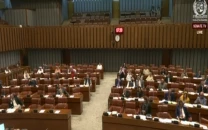'July wetter compared to last year'
Early July rains surpass 2024 levels in most regions

As climate change tightens its grip, making rains more unforgiving and mercurial, this year's monsoon has brought noticeably heavier rainfall to most parts of the country compared to the same period last year.
According to a comparative report issued by the Pakistan Meteorological Department (PMD), rainfall recorded between July 1 and July 14, exceeded last year's levels in nearly all regions, except Sindh and Gilgit-Baltistan, which continued to receive below-normal precipitation.
The PMD noted that the first fortnight of the 2025 monsoon season saw above-normal rainfall across large swathes of the country.
Punjab, in particular, was soaked with 81.6% more rain than average, a sharp rise even compared to the already elevated 72.4% above-normal rainfall it received during the same period in 2024.
Similarly, Azad Kashmir saw an increase of 19.3% in rainfall over normal levels, while Khyber Pakhtunkhwa received 34.9% more than its seasonal average.
The most dramatic surge was recorded in Balochistan, where 2025 rainfall soared 187% above normal levels, whereas the province had witnessed normal precipitation during this timeframe last year.
In contrast, Sindh remained drier than usual for the second year in a row. Rainfall was 66.2% below normal in 2025 and 68.6% below average in 2024. Gilgit-Baltistan similarly recorded lower-than-average rainfall across both years during the same period.
Meanwhile, the Provincial Disaster Management Authority (PDMA) has warned of rising water levels in rivers due to a combination of heavy monsoon rains and glacial melt.
The weather pattern is expected to persist until July 17.
The PDMA spokesperson confirmed that low-level flooding has been reported at Tarbela and Taunsa along the Indus River, while flows at Chashma and Kalabagh remain normal.
Water levels in the Ravi, Chenab, Jhelum and Sutlej rivers are currently within safe limits, as are the hill torrents (Rod Kohi) in Dera Ghazi Khan.



















COMMENTS
Comments are moderated and generally will be posted if they are on-topic and not abusive.
For more information, please see our Comments FAQ